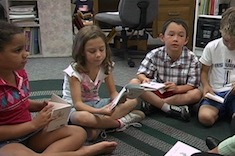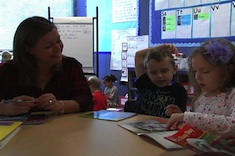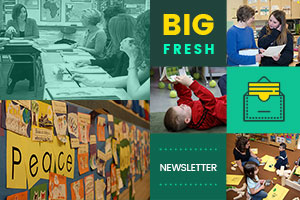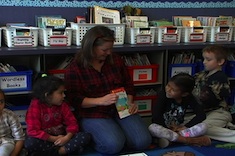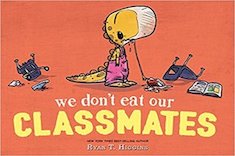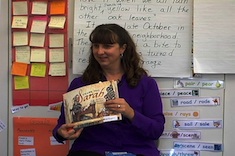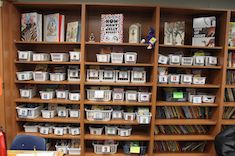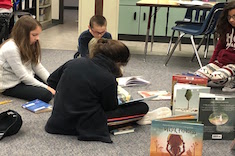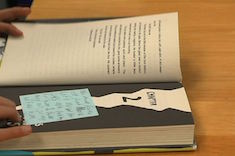Library
Choice Literacy Articles & Videos
The Choice Literacy library contains over 3,000 articles and 900 videos from 150+ contributors. Classic Classroom and Literacy Leadership subscribers have access to the entire library. Content is updated continuously, with five to six new features published each week.
Latest Content
Guided Reading Run Amok
Shari Frost helps a teacher who has guided reading groups that have run amok, and discovers that the real culprit is a lack of time for reading and writing in the literacy block.
Three Challenges for the 40 Book Challenge
Matt Renwick encourages you to ask a few critical questions before you adopt the 40-Book Challenge or any other activity with a number for a goal you’re going to be tied to all year long in your classroom.
Levels and What’s Appropriate
“How do you know what level they have selected?” a visitor asks Bitsy Parks as she observes during a first-grade independent reading period. “I don’t,” Bitsy responds, and explains why it is a beautiful thing.
Making Meaning with Simple Text: Conferring in First Grade
Katrina Edwards confers with a first grader, looking beyond the level of the book early in the year to ensure the child is engaging with the story. She helps the child notice changes in the simple text and illustrations.
The Big Fresh August 11, 2018 Stubborn Gladness
We look at first lessons and introductions to students in this week’s Big Fresh.
Getting to Know Each Other Through the Work
Mark Levine explains why he dives right into work in his middle school classroom, rather than getting-to-know-you activities. And through the work, a community is born.
Organizing for Middle School
Tara Smith covers all the basics of how to get organized in middle school for the first days of literacy workshops.
First-Grade Reading Share: Focus on Conferring and Strategies
Bitsy Parks uses reading share time early in the year to describe and summarize the work in two conferences to help students learn how conferring, independent reading time, and strategy practice work. One of the books used in a conference is from a recent read aloud.
Read Alouds to Start the Year in First Grade
Bitsy Parks selects read alouds for the first weeks of school for many different purposes, from building community to helping her first graders navigate the classroom library.
The Big Fresh August 4, 2018 Surprise
We look at creative ways to teach required units in this week's Big Fresh.
Doing the Writing in a Unit
One way to keep your instruction fresh in a required writing unit is to take on the tasks and topics yourself. Dana Murphy finds completing the assignments herself is well worth her time, and gives her a treasure trove of notebook entries to use in her conferring.
Writing on Someone Else’s Topic
Shari Frost finds she has to do required, on-demand writing for a new job, and in the process develops a new appreciation for how teachers struggle with rigid reading and writing programs.
Fourth-Grade Minilesson: Character Traits
Gigi McAllister helps her fourth graders develop the characters in their writing with a minilesson. She uses three mentor texts, one of which is her own writing.
Fall Fluster
Bitsy Parks is stressed from trying to “cover” all the lessons in the first required reading unit of the year with her first graders. She takes a deep breath and decides to integrate more of her own lessons into her instruction.
The Big Fresh July 28, 2018 Passion for Work
We look at launching classroom libraries in this week’s Big Fresh.
How to Get Books Off Shelves
Christy Rush-Levine writes about the push and pull of wanting to put books into students’ hands, and needing at the same time to give them room to explore the classroom library.
Enticing Young Readers: First-Grade Group
Bitsy Parks helps a small group of first graders engage with the library early in the year by introducing a series with companion stuffed animals.
Fifth-Grade Book Talk: Wish Girl
Katherine Sokolowski builds interest in a new book in the classroom library through a book talk on Wish Girl.
Keeping the Classroom Library Current
Franki Sibberson explains how she watches students closely and adjusts her library based on what she sees all year long.
The Big Fresh July 21, 2018 Hitting Save
We reflect on routines in this week’s Big Fresh.
And This Makes Me Think
Dana Murphy considers how teachers can make writing workshop routines more cozy and like writing at home.
Wounded Warriors: Trauma and Literacy Routines
Ruth Ayres explains which workshop routines are essential for children who come to school bearing trauma.
First-Grade Read and Think Check-In
Katrina Edwards demonstrates a read and think check-in from her first-grade classroom.
When One Door Closes
Gretchen Schroeder finds new routines in her high school workshop means letting go of old expectations.
The Big Fresh July 14, 2018 Work and Play
We consider the difference between engagement and compliance in this week’s Big Fresh.
Seeking Personal Relevance
Christy Rush-Levine has to figure out how to engage a class of students that is compliant and dutiful, but shows little passion for reading and writing.
Invitations vs. Accountability
It’s not an invitation if students are required to accept it. Franki Sibberson explains how engagement depends upon true choice and lots of options in her fifth-grade classroom.
The Year’s First Read Aloud
From length to heart, Tara Smith provides seven criteria for selecting the first read aloud of the year that can engage students right from the start.
Student Notes: Slow Down and Think
Fifth grader Orion uses sticky notes to make questions and predictions at the end of each chapter.
The Big Fresh June 23, 2018 Time to Write
We look at strategies for self care in this week’s Big Fresh.
Browse Content By
Type
Category
- Assessment Tools
- Big Fresh Archives
- Booklists
- Choice Numeracy
- Classroom Design
- Common Core
- Community Building
- Conferring
- Content Literacy
- Digital Literacy
- English Language Learners
- Equity
- Family Relations
- Free Samples
- Guiding Groups
- Leadership
- Literacy Coaches
- Mentor Texts
- Minilessons
- New Teacher Mentors
- Podcasts
- Poetry
- Quote Collections
- Reading Strategies
- Self Care
- Struggling and Striving Learners
- Talking and Listening
- Teacher Study Groups
- Teaching Reading
- Teaching Writing
- Word Study and Vocabulary
Author
- Melissa Quimby
- Nawal Qarooni
- Gwen Blumberg
- Julie Cox
- The Lead Learners
- Hannah Tills
- Josie Stewart
- Ruth Metcalfe
- Mallory Messenger
- Becca Burk
- Jodie Bailey
- Vivian Chen
- Mary Brower
- Tiffany Abbott Fuller
- Stephanie Affinito
- Ruth Ayres
- Leigh Anne Eck
- Heather Fisher
- Shari Frost
- Julie Johnson
- Suzy Kaback
- Gigi McAllister
- Shirl McPhillips
- Melanie Meehan
- Cathy Mere
- Debbie Miller
- Tara Barnett and Kate Mills
- Tammy Mulligan
- Dana Murphy
- Bitsy Parks
- David Pittman
- Brenda Power
- Heather Rader
- Matt Renwick
- Mandy Robek
- Christy Rush-Levine
- Gretchen Schroeder
- Jen Schwanke
- Brian Sepe
- Katherine Sokolowski
- Stella Villalba
- Jennifer Vincent
Grade Level
Choice Literacy Membership
Articles
Get full access to all Choice Literacy article content
Videos
Get full access to all Choice Literacy video content
Courses
Access Choice Literacy course curriculum and training

